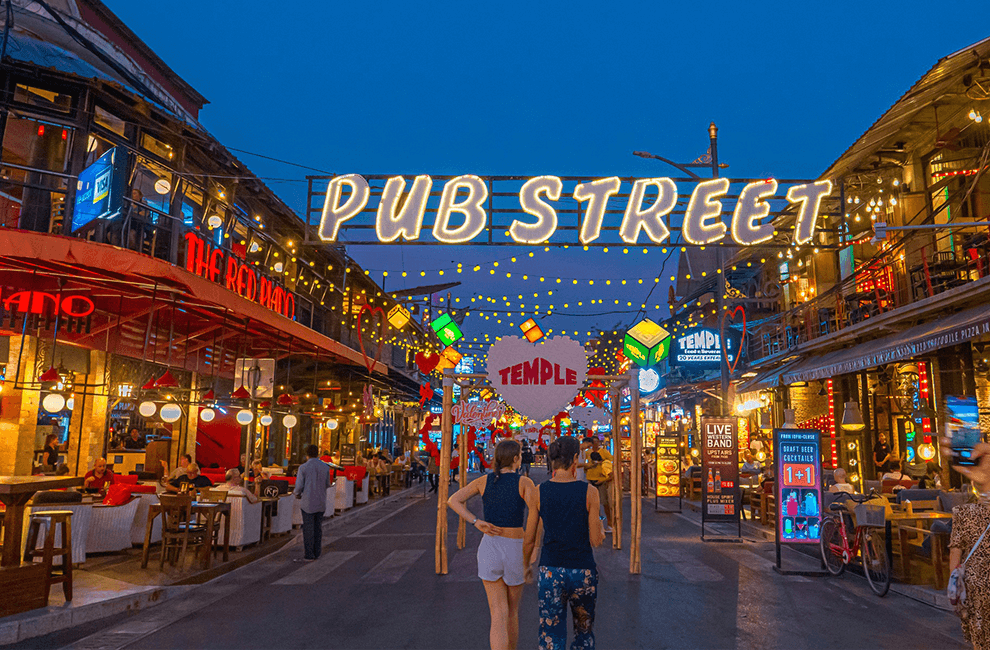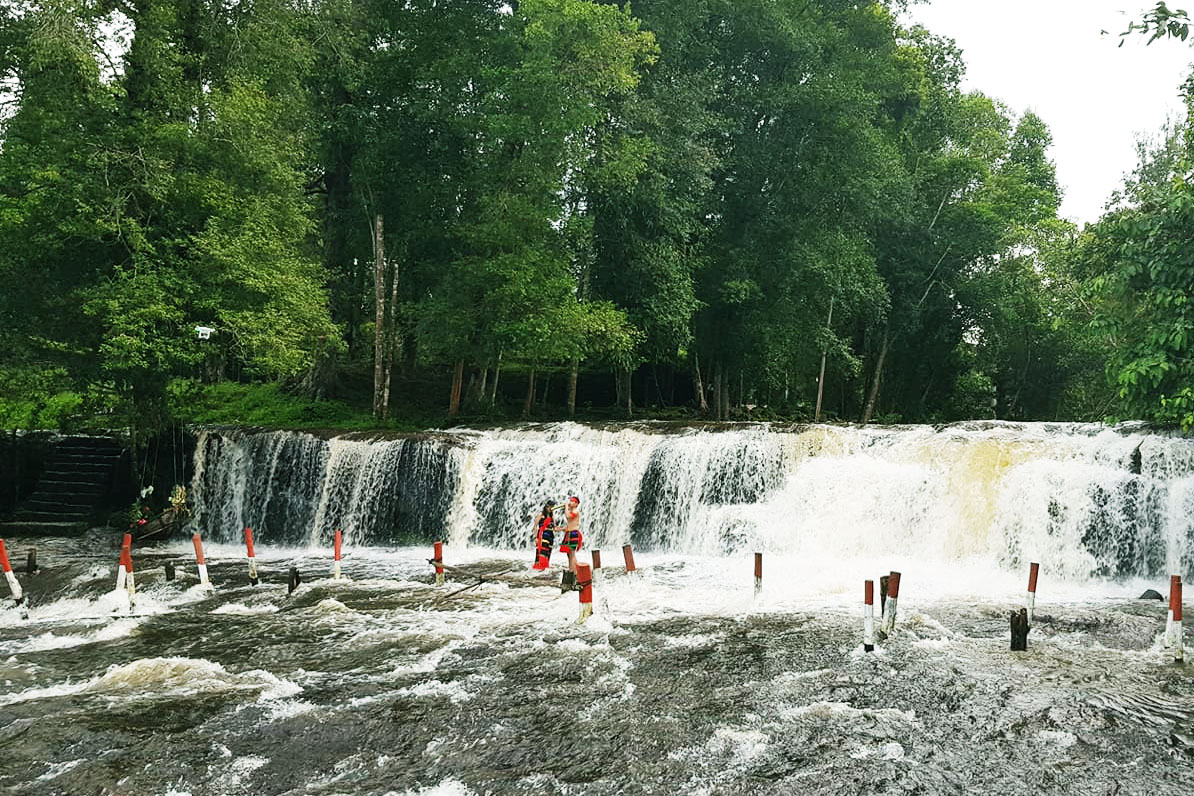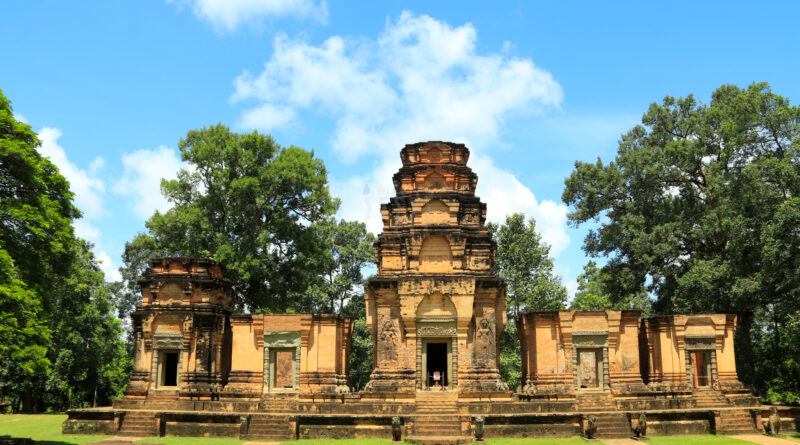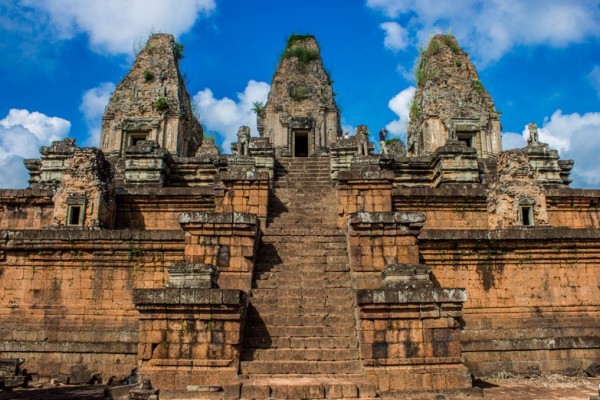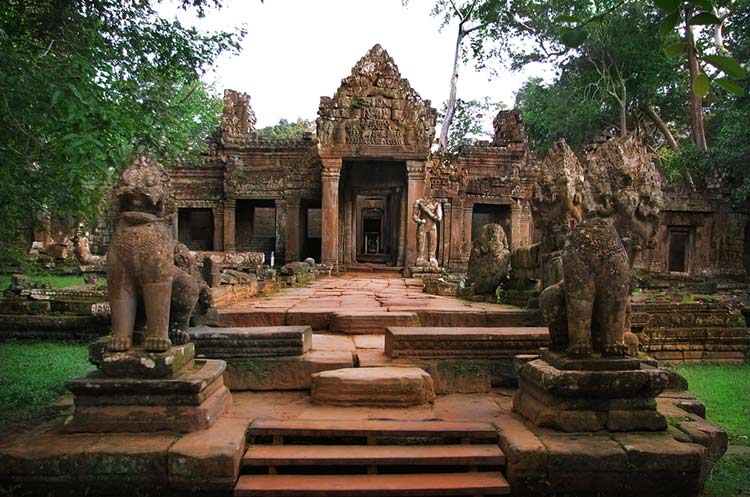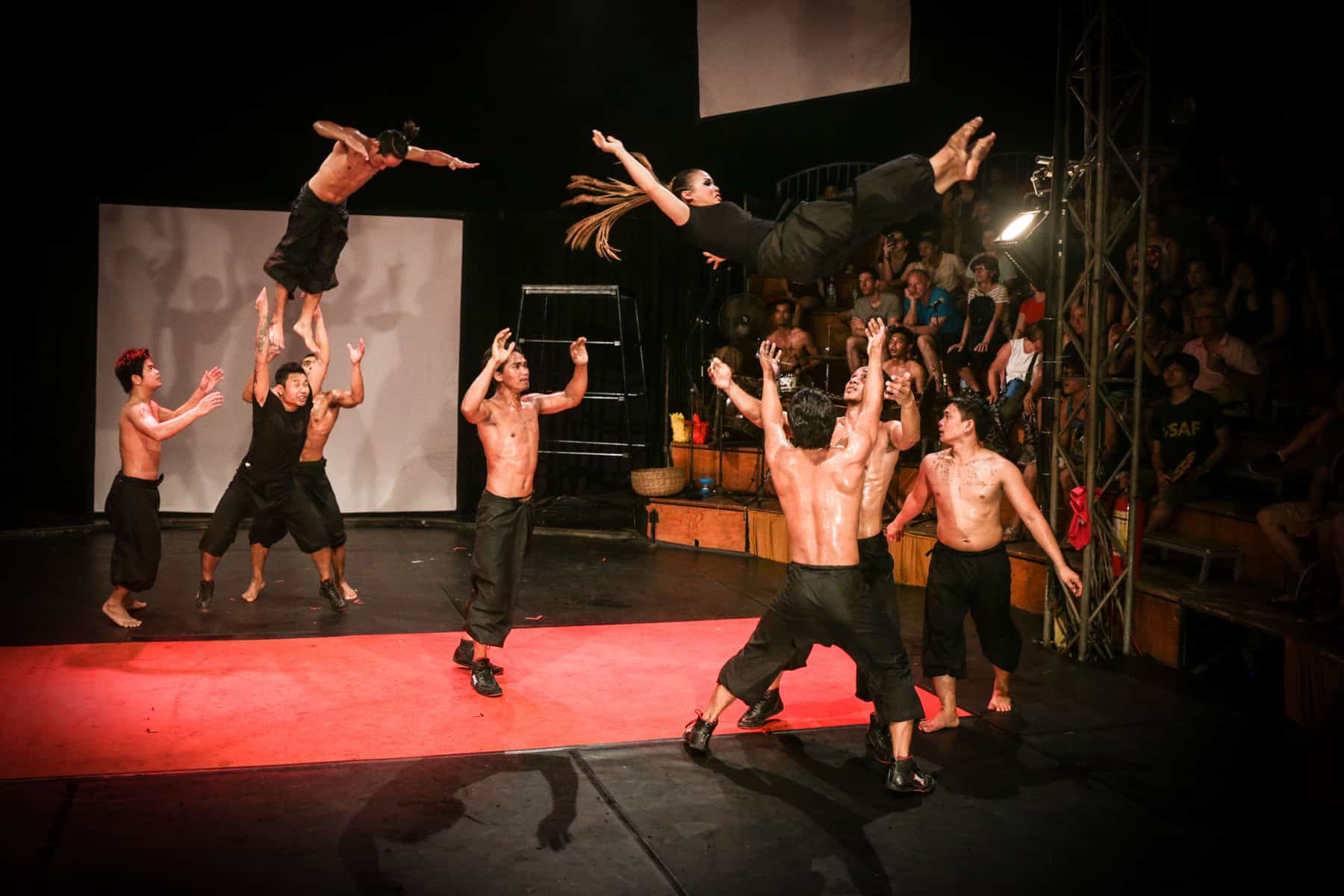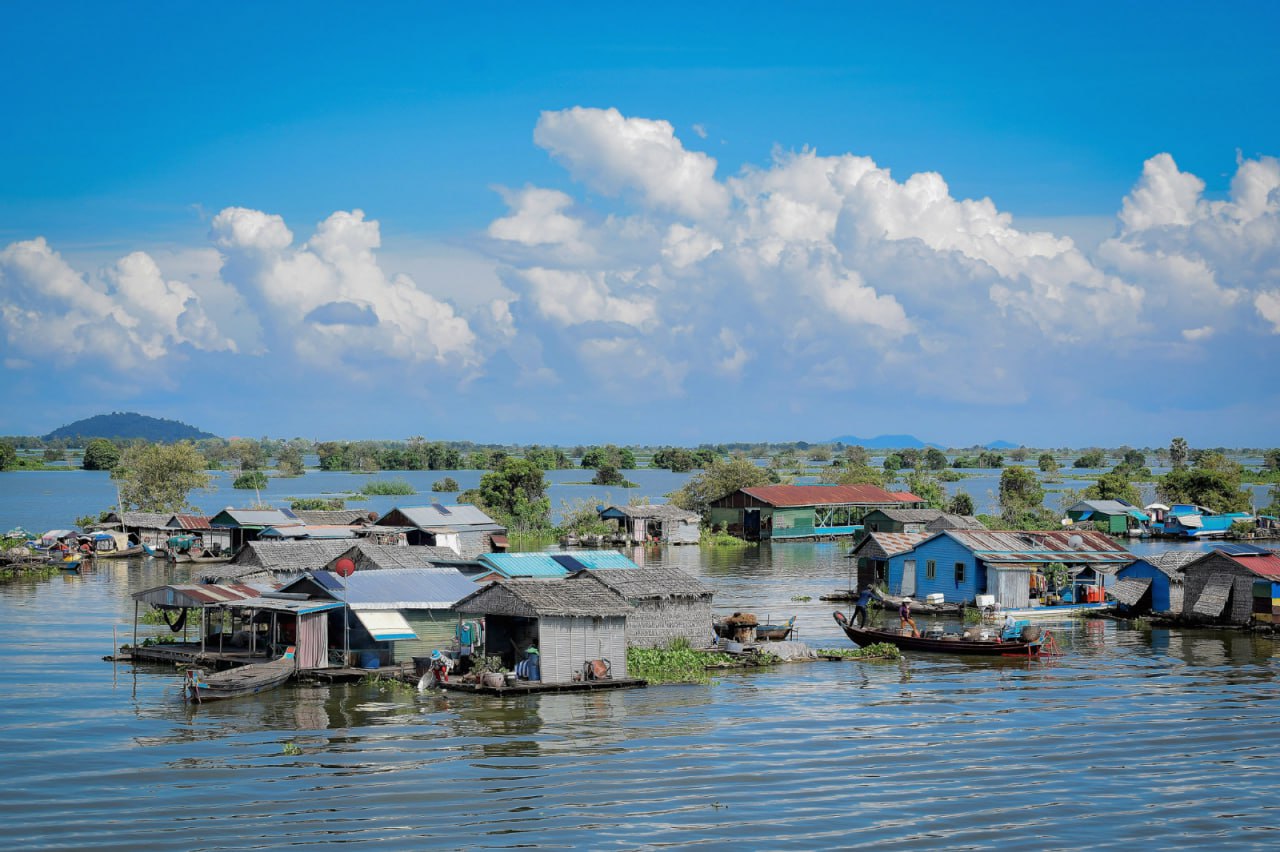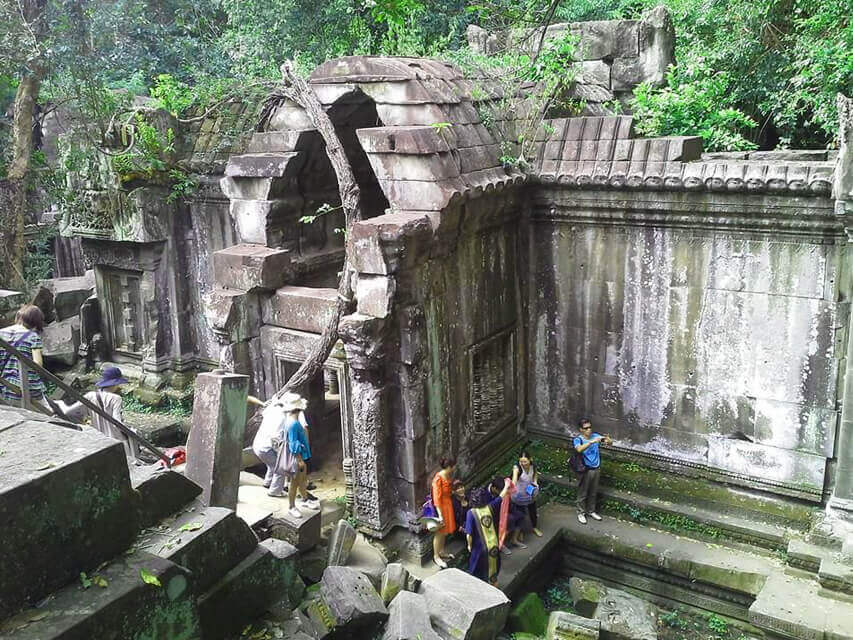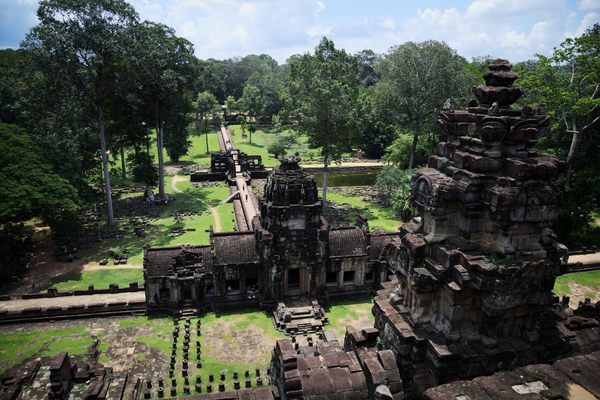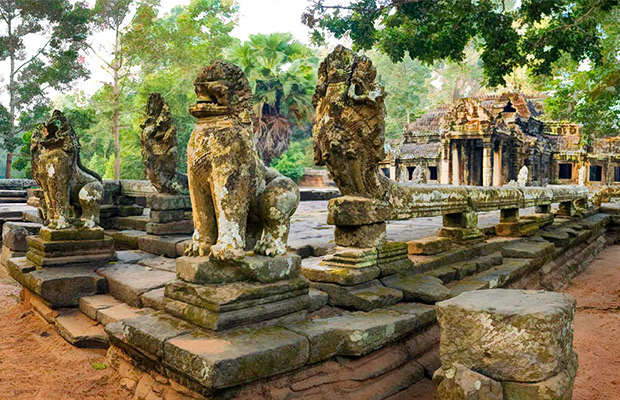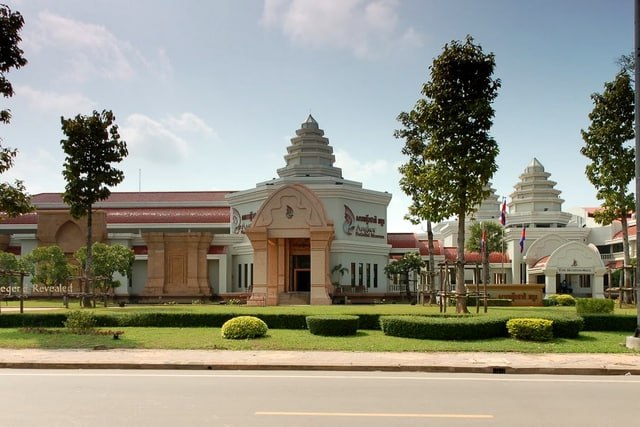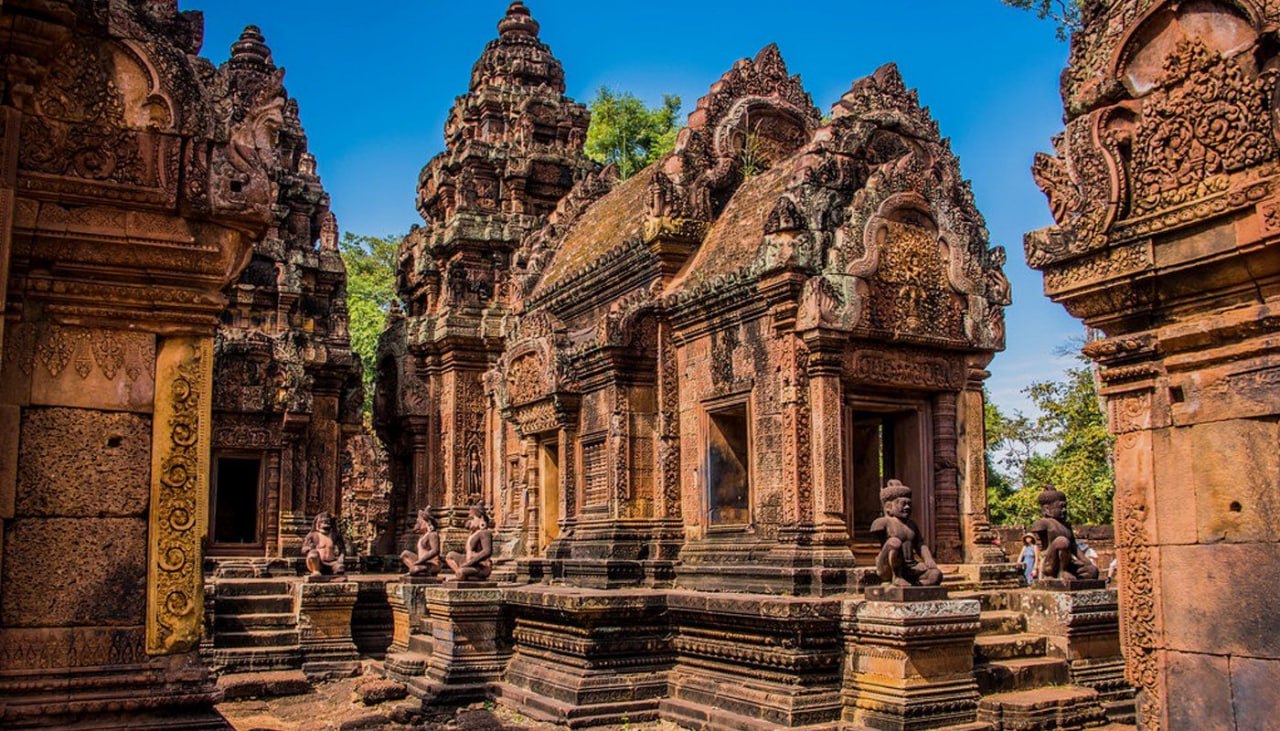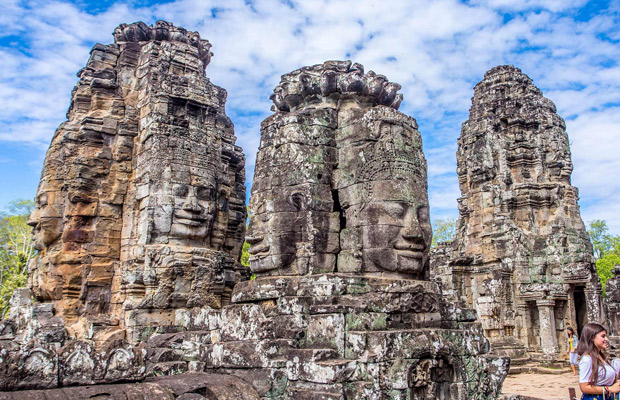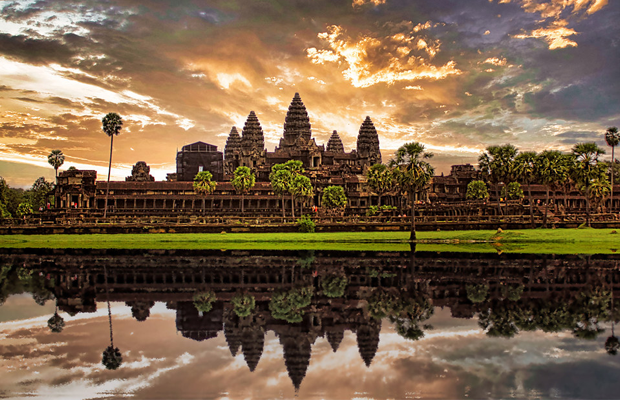Siem Reap
Siem Reap
The Terrace of the Leper King is another significant and mysterious monument within the Angkor Archaeological Park in Siem Reap, Cambodia. It is located just north of the Terrace of the Elephants, within the ancient city of Angkor Thom, and like many other structures in the area, it carries both historical and symbolic significance.
The Terrace of the Leper King was built during the 12th century under the reign of King Jayavarman VII, who is responsible for many of the architectural marvels in Angkor, including the famous Bayon Temple and the Terrace of the Elephants. This terrace, like other structures in Angkor Thom, is primarily made of sandstone and features detailed relief carvings. The terrace’s name, “Terrace of the Leper King”, is somewhat enigmatic. It is not clear why it was named after the “Leper King,” and there are several theories about its origin:
One theory suggests that the “Leper King” refers to a royal figure who suffered from leprosy. This figure might have been represented by the statue at the terrace’s summit, which is a stone sculpture of a king, sometimes interpreted as a symbolic representation of the Leper King. Another theory is that the name derives from the statue’s appearance—over time, the weathering of the stone may have created a pockmarked surface that resembled the skin of someone suffering from leprosy. The Terrace of the Leper King is a small, rectangular structure, measuring about 25 meters long and 4 meters high. It consists of a low platform with walls adorned with intricate bas-reliefs.
Takeo Temple is a well-known Angkorian temple located in the Siem Reap province of Cambodia. It is part of the Angkor Archaeological Park, which is home to many of the most famous temples in Cambodia, including Angkor Wat, Bayon, and Ta Prohm. Takeo Temple is one of the many temples in this region, and it holds significant historical and architectural value. Takeo Temple, also known as Tevoda Temple or Tevoda, was built during the late 10th century, specifically during the reign of King Jayavarman V (968–1001 AD). It was dedicated to the Hindu god Shiva, though it is also associated with various Buddhist elements, reflecting the religious transitions of the region during that time. Some sources suggest the temple’s name also refers to the “mountain” (Takeo), which symbolizes a sacred connection to the heavens. Takeo Temple is a pyramid-shaped temple constructed from sandstone and brick. It follows the classic Khmer architectural style, typical of temples built during the Angkorian period. The temple consists of a series of terraces that ascend to a central shrine at the top, with each level decorated with carvings and stone sculptures.
Pub Street is one of the most famous and vibrant areas in Siem Reap, Cambodia. It’s located in the heart of the city, near the Old Market (Psar Chaa), and is known for its lively atmosphere, especially in the evenings. Pub Street is a popular destination for both locals and tourists, offering a wide range of entertainment, dining, shopping, and nightlife options. Pub Street is packed with numerous restaurants, bars, and street food stalls that cater to a variety of tastes. The area comes to life at night, with neon lights, music, and bustling crowds. Many visitors flock to Pub Street after a day of sightseeing at the Angkor temples to enjoy the nightlife. There are various types of entertainment, from casual pubs to clubs with DJs. Pub Street is often home to street performers, musicians, and even art displays. The atmosphere is lively and filled with a mix of music, live performances, and entertainment. During festivals or special events, Pub Street hosts more elaborate performances, such as traditional dance and live bands.
Kulen Mountain (also known as Phnom Kulen) is a significant and sacred mountain located in the northern part of Siem Reap province, Cambodia. It holds great historical, cultural, and religious importance, not only for its natural beauty but also for its role in the early history of the Khmer Empire. It is considered one of the most important pilgrimage sites in Cambodia and is part of the Kulen Mountain National Park. Phnom Kulen is often referred to as the “birthplace of the Khmer Empire.” It is believed that in the 9th century, King Jayavarman II declared himself the first king of Cambodia here, marking the beginning of the Angkorian period. The mountain is home to several ancient structures and carvings that highlight its religious importance, particularly in Hinduism and later in Buddhism. One of the most famous natural features of Kulen Mountain is the Kulen Waterfall. This stunning, multi-tiered waterfall is surrounded by lush greenery, creating a serene and picturesque atmosphere. The waterfall has become a popular spot for tourists and locals alike to relax, swim, and enjoy the natural beauty of the area. The clear, cool water provides a refreshing break from the heat of the surrounding region. Kulen Mountain is a haven for nature lovers. The surrounding area features dense forests, diverse wildlife, and a rich ecosystem. It is a popular destination for hiking and trekking, with several trails leading to hidden temples, caves, and stunning viewpoints..
The Kravan Temple is a small yet historically significant temple located in Siem Reap, Cambodia. It is part of the Angkor Archaeological Park, a UNESCO World Heritage Site, and is often overlooked by many tourists compared to the more famous temples like Angkor Wat or Bayon. However, the Kravan Temple holds a unique charm and offers valuable insight into the architecture and artistic styles of the Khmer Empire. The Kravan Temple was built during the early 10th century (around 921 AD) by the Khmer king Harshavarman I. It is dedicated to the Hindu god Vishnu, reflecting the Hindu influences in Cambodia’s religious history. The Kravan Temple is constructed in the brick style, which was typical of Khmer temples from the period. Unlike the sandstone structures of larger temples in Angkor, Kravan is primarily made from fired bricks, giving it a distinct appearance. The temple was originally dedicated to Vishnu, one of the principal deities of Hinduism, which was the predominant religion in the Khmer Empire at the time. However, as the region later transitioned to Buddhism, the temple’s significance and purpose may have evolved.
Ta Prohm is a captivating temple complex located in the Angkor Archaeological Park in Cambodia. Built in the late 12th and early 13th centuries by King Jayavarman VII, Ta Prohm is a unique and atmospheric temple that has been left in a partially ruined state, with the jungle reclaiming much of its structure. King Jayavarman VII, a powerful ruler known for his ambitious building projects and patronage of Buddhism, commissioned the construction of Ta Prohm as a Mahayana Buddhist monastery and university. The temple was dedicated to the king’s mother and symbolized the union of religion and royalty in Khmer society. Ta Prohm is renowned for its distinctive architectural style, which features a combination of traditional Khmer design elements and innovative features such as flat roofs, square galleries, and cruciform sanctuaries. The temple complex covers an area of over 40 hectares and consists of multiple enclosures, courtyards, towers, and galleries adorned with intricate carvings and bas-reliefs. One of the most striking features of Ta Prohm is the way in which the temple has been enveloped by the roots of giant silk-cotton trees, creating a dramatic and otherworldly atmosphere.
Constructed in the late 10th century during the reign of King Rajendravarman II, and completed by his successor, King Jayavarman V, Pre Rup is one of the oldest temples in the Angkor complex. It was dedicated to the Hindu god Shiva and served as a state temple for performing important ceremonies, including royal cremations. Pre Rup is renowned for its exquisite architectural design, characterized by towering brick and laterite structures with intricate carvings and decorative elements. The temple features a central sanctuary tower surrounded by three tiers of diminishing size, reminiscent of a stepped pyramid. Pre Rup is a popular spot for sunrise and sunset viewing due to its elevated position and unobstructed views. Many visitors flock to the temple in the early morning or late afternoon to witness the breathtaking spectacle of the sun casting golden hues over the temple’s spires and surrounding landscape. Pre Rup Temple offers visitors a captivating glimpse into Cambodia’s ancient past, with its impressive architecture, serene atmosphere, and stunning vistas making it a must-visit destination within the Angkor Archaeological Park.
Koh Ker is a remote archaeological site in northern Cambodia that served as the capital of the Khmer Empire for a brief period during the early 10th century. The temple complex is located in the dense forests of the Preah Vihear province, approximately 120 kilometers northeast of Angkor Wat. Koh Ker was established as the capital by King Jayavarman IV, who ruled from 928 to 944 AD. During his reign, Jayavarman IV initiated a series of ambitious building projects, including the construction of numerous temples and shrines at Koh Ker. The most notable of these structures is the Prasat Thom, a towering seven-tiered pyramid temple that stands at the center of the site.
The architecture of Koh Ker is distinct from that of other Khmer temples, with a more angular and geometric style that reflects the artistic experimentation of the period. The temple complex covers an area of approximately 81 square kilometers and includes more than 180 structures, many of which are still buried beneath the jungle vegetation. After Jayavarman IV’s death, Koh Ker was briefly abandoned before being reclaimed by later Khmer rulers. The site continued to be used as a religious and ceremonial center until the 13th century when it was largely abandoned and fell into disrepair.
In the late 19th century, French archaeologists began to uncover and restore the temples of Koh Ker, bringing international attention to the site. Today, Koh Ker is a UNESCO World Heritage site and a popular destination for tourists seeking to explore Cambodia’s rich history and cultural heritage. Visitors to Koh Ker can marvel at the impressive architecture of the temples, wander through the overgrown ruins, and imagine what life was like during the heyday of the Khmer Empire. The site offers a unique opportunity to step back in time and experience the grandeur and mystery of Cambodia’s ancient past.
Phare, the Cambodian Circus is a unique and vibrant performance art experience that combines traditional Cambodian culture with contemporary circus arts. It is an exciting and dynamic show that has gained international acclaim for its powerful storytelling, impressive acrobatics, and deep cultural significance. The circus is performed by the Phare Ponleu Selpak (PPS) organization, which is based in Battambang, Cambodia. Phare Ponleu Selpak (PPS), the organization behind the circus, was founded in 1994 by a group of Cambodian refugees who returned from the Thai border camps after the fall of the Khmer Rouge regime. The mission of PPS is to help young people from disadvantaged backgrounds, particularly those from rural and impoverished areas, by providing them with education, vocational training, and a platform for artistic expression. The circus performances are an important part of PPS’s broader efforts to empower youth, preserve Cambodian culture, and promote creativity and self-expression. The Phare Circus performances blend traditional Cambodian stories, modern circus techniques, and contemporary theater. The shows feature acrobatics, juggling, clowning, aerial acts, and dance, all set to live music and accompanied by a rich narrative.
Artisans Angkor was created as a way to preserve Cambodia’s cultural heritage, promote sustainable development, and empower local communities through vocational training and economic empowerment. Artisans Angkor offers comprehensive training programs in various traditional crafts to young Cambodians from disadvantaged backgrounds, equipping them with the skills, knowledge, and resources needed to become skilled artisans and entrepreneurs. The organization’s workshops are led by experienced master craftsmen who pass on their expertise and techniques to the next generation of artisans. By upholding high standards of craftsmanship, creativity, and innovation, Artisans Angkor ensures the production of exquisite handmade products that showcase the beauty, authenticity, and quality of Khmer arts and crafts. Artisans Angkor produces a wide range of handmade products, including sculptures, jewelry, textiles, home decor items, accessories, and gifts that are inspired by Cambodia’s cultural heritage and natural beauty.
.
The Terrace of the Elephants is one of the most iconic and remarkable structures in the Angkor Archaeological Park, located in Siem Reap, Cambodia. It is a royal platform that was part of the larger complex of Angkor Thom, the last capital of the Khmer Empire. The Terrace of the Elephants was built in the late 12th century during the reign of King Jayavarman VII (1181–1218 AD). Jayavarman VII was one of the most powerful and influential kings of the Khmer Empire and is also credited with expanding the empire’s territory and building many of its most famous monuments. The terrace was likely used for royal ceremonies, public appearances, and rituals, as well as a platform for the king and his court to observe parades, military victories, and other state events. It may also have served a ceremonial function, as evidenced by its symbolic depictions of elephants, which were revered in Khmer culture.
Kampong Phlouk Floating Village is a unique and enchanting community located in the heart of the Tonle Sap Lake, near Siem Reap, Cambodia. This picturesque village is renowned for its stilted houses, floating markets, and vibrant way of life that revolves around the ebb and flow of the water. Visitors to Kampong Phlouk have the opportunity to immerse themselves in the rich culture and traditions of the local residents, who have adapted to living on the water for generations. The residents of Kampong Phlouk Floating Village lead a fascinating lifestyle that is deeply connected to the water. The village is home to a diverse community of fishermen, farmers, and artisans who rely on the lake for their livelihoods. Visitors can witness traditional fishing techniques, explore floating gardens, and interact with locals as they go about their daily routines. The village is also known for its colorful floating markets, where vendors sell fresh produce, handicrafts, and souvenirs from their boats. Kampong Phlouk Floating Village is also a hub for ecotourism and conservation efforts in Cambodia. The village is surrounded by a rich ecosystem of mangrove forests, wetlands, and bird sanctuaries that support a diverse array of wildlife, including rare bird species and endangered aquatic animals.
Beng Mealea is an ancient temple located in the dense forests of Cambodia, approximately 40 kilometers east of the Angkor Archaeological Park. The temple is believed to have been built in the early 12th century during the reign of King Suryavarman II, the same king who commissioned the construction of the famous Angkor Wat temple. Beng Mealea, which means “Lotus Pond” in Khmer, was constructed as a Hindu temple dedicated to the god Vishnu. The temple’s layout and architectural style closely resemble that of Angkor Wat, leading scholars to believe that it served as a prototype for the larger and more famous temple complex. The temple remained largely hidden and untouched until the late 19th century when French explorers rediscovered it during their expeditions through Cambodia. In recent years, Beng Mealea has become a popular destination for tourists seeking to experience the mysterious atmosphere of an ancient temple engulfed by nature. In 1992, Beng Mealea was included in the UNESCO World Heritage Tentative List as part of the Angkor Archaeological Park, recognizing its historical significance and architectural beauty. Efforts to preserve and restore the temple have been ongoing, allowing visitors to witness the grandeur of this hidden gem of Khmer architecture.
The Baphuon temple is a magnificent ancient temple located within the Angkor Archaeological Park in Cambodia. Built in the mid-11th century by King Udayadityavarman II, the Baphuon is a grand and imposing temple mountain that served as a state temple dedicated to the Hindu god Shiva. The temple complex covers an area of approximately 120 hectares and features a central sanctuary tower that rises to a height of over 30 meters, symbolizing Mount Meru, the mythical abode of the gods in Hindu cosmology. King Udayadityavarman II, a powerful ruler known for his ambitious building projects and devotion to Hinduism, commissioned the construction of the Baphuon as a grandiose state temple to showcase his wealth, power, and piety. The temple’s name, which means “shrine of the sacred peak,” reflects its symbolic association with the cosmic mountain at the center of the universe. One of the most remarkable features of the Baphuon is its historical and cultural significance as a center of religious worship, royal ceremonies, and political power. The temple complex served as a focal point for state rituals, royal processions, and public gatherings, reflecting the close relationship between religion, monarchy, and society in ancient Khmer civilization.
Banteay Kdei, meaning “Citadel of Chambers,” is an enchanting ancient temple located within the Angkor Archaeological Park in Cambodia. Constructed in the late 12th to early 13th centuries during the reign of King Jayavarman VII, Banteay Kdei is a serene and atmospheric temple complex that served as a Buddhist monastery and spiritual retreat. The history of Banteay Kdei is closely intertwined with the reign of King Jayavarman VII, a powerful and visionary ruler known for his grand building projects, religious reforms, and patronage of Buddhism. Inspired by his devotion to Buddhism and desire to create a peaceful sanctuary for meditation and contemplation, King Jayavarman VII commissioned the construction of Banteay Kdei as a place of worship, education, and spiritual reflection. Banteay Kdei is renowned for its distinctive architectural features, including its four-faced towers reminiscent of Bayon-style temples, cruciform galleries with vaulted ceilings, and delicate sandstone carvings that showcase the artistic mastery of Khmer craftsmen. Today, Banteay Kdei stands as a poignant reminder of Cambodia’s rich cultural heritage, spiritual traditions, and architectural legacy. The temple complex is a UNESCO World Heritage site and a symbol of the enduring beauty, grace, and wisdom of Khmer civilization.
The Angkor National Museum is a cultural institution located in Siem Reap, Cambodia, near the famous Angkor Archaeological Park. The museum is dedicated to educating visitors about the history, art, and architecture of the ancient Khmer Empire, which reached its peak in the 12th century under King Suryavarman II. The idea for the museum was first proposed in the early 2000s as a way to protect and promote Cambodia’s cultural heritage. The project was supported by the Cambodian government and several international organizations, including UNESCO. Construction of the museum began in 2005 and was completed in 2007, with the official opening taking place later that year. The Angkor National Museum is divided into several galleries, each focusing on different aspects of Khmer history and culture. The museum’s collection includes a wide range of artifacts, including sculptures, ceramics, and religious objects dating back to the Angkorian period. The exhibits are accompanied by informative displays and multimedia presentations that help visitors understand the significance of the artifacts and their place in Khmer history.
The Banteay Srei temple is a 10th-century Hindu temple dedicated to the god Shiva. It is renowned for its intricate and well-preserved pink sandstone carvings, which are considered some of the finest examples of classical Khmer art. The temple was built in 967 AD by a courtier named Yajnavaraha, who served as an advisor to King Rajendravarman II. Banteay Srei means “Citadel of Women” or “Citadel of Beauty” in Khmer, and it is believed that the temple’s delicate carvings were done by women due to their exquisite detail and craftsmanship. Banteay Srei is relatively small compared to other temples in the Angkor region, but its intricate carvings and well-preserved condition make it a popular tourist destination. The temple was rediscovered in 1914 and has since undergone extensive restoration to protect its delicate carvings from weathering and erosion. Today, Banteay Srei is considered one of the jewels of Khmer art and architecture, showcasing the skill and artistry of the ancient Khmer civilization. It is a UNESCO World Heritage site and a must-visit for anyone interested in Cambodian history and culture.
The Bayon Temple is a striking and enigmatic temple complex located at the heart of the ancient city of Angkor Thom in Cambodia. Built in the late 12th or early 13th century by King Jayavarman VII, the Bayon Temple is renowned for its impressive architecture, intricate bas-reliefs, and iconic stone faces. King Jayavarman VII, one of the most powerful and ambitious rulers of the Khmer Empire, commissioned the construction of the Bayon Temple as the state temple of his capital city, Angkor Thom. The temple was dedicated to Mahayana Buddhism, reflecting the king’s religious beliefs and his desire to create a monumental symbol of his reign.The bas-reliefs of the Bayon Temple depict a wide range of subjects, including historical events, mythological scenes, and everyday life in ancient Khmer society. Over the centuries, the Bayon Temple fell into disrepair and was partially reclaimed by the jungle until it was rediscovered and restored in the 20th century. Today, it stands as a UNESCO World Heritage Site and a testament to the artistic and architectural achievements of the Khmer civilization.
Angkor Wat is one of the most iconic and impressive temple complexes in the world. Built in the early 12th century by King Suryavarman II, Angkor Wat is a masterpiece of Khmer architecture and a symbol of the grandeur and power of the Khmer Empire. King Suryavarman II, a powerful ruler who reigned from 1113 to 1150, commissioned the construction of Angkor Wat as a state temple and mausoleum dedicated to the Hindu god Vishnu. The temple was designed to serve as a spiritual and political center, reflecting the king’s devotion to Vishnu and his desire to establish a lasting legacy. Angkor Wat is renowned for its monumental scale, intricate carvings, and sophisticated architectural design. The temple complex covers an area of over 162 hectares and consists of multiple galleries, courtyards, towers, and basins arranged in a symmetrical layout that reflects the Hindu cosmology. After the decline of the Khmer Empire in the 15th century, Angkor Wat was gradually abandoned and fell into disrepair until it was rediscovered by French explorers in the 19th century. Since then, the temple has been extensively restored and preserved, becoming a UNESCO World Heritage Site and a symbol of Cambodia’s cultural heritage.
Create Your Dream Tour!
Feel free to adjust any details or add specific information relevant to your destination or travel agency. Let me know if you need further customization!

